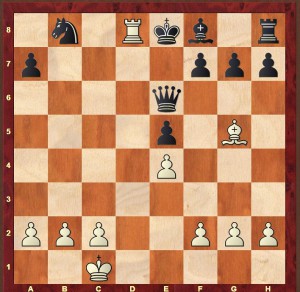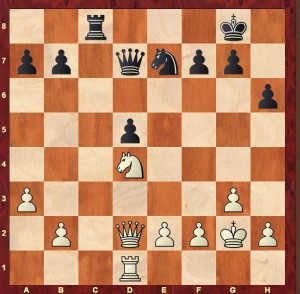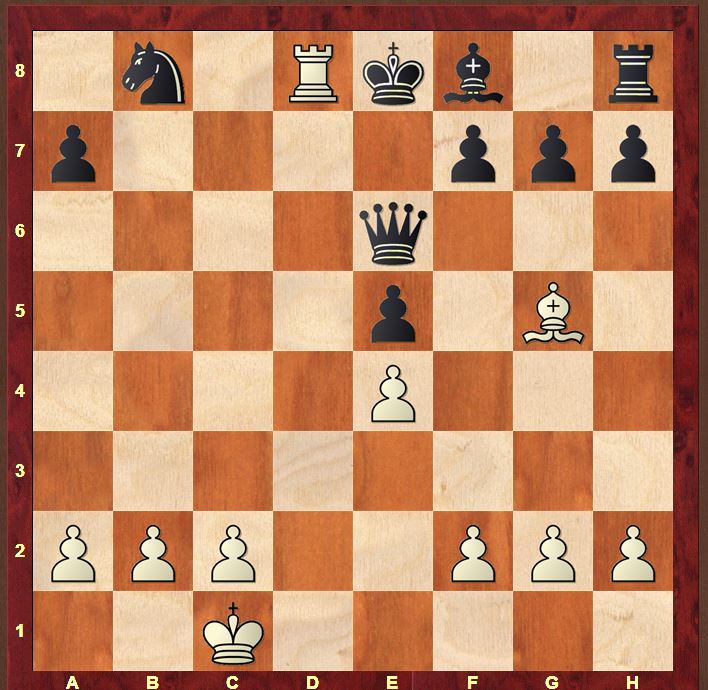Last weekend was my debut as a birthday present! A colleague asked me whether I would be interested in giving a chess lesson to his brother who had just turned 50 and who was keen on chess. Not only did it turn out to be a lovely Sunday, I also learnt a lot myself! The lesson was divided up into 3 parts: Opening, Middlegame and Endgame. For the opening part – inspired by Nigel Short’s infectious enthusiasm for this great player of the 1850’s – I used the games of Paul Morphy to illustrate the concept of rapid development. While demonstrating the classic attack against Carl Isouard, I was suddenly struck by the similarity with the 1st game of the Alekhine-Bogolyubov World Championship of 1929. Just to start off, I’ll put the games next to each other without notes. Don’t worry if you don’t notice anything: we’ll discuss it in detail later.
Morphy,Paul – Isouard,Carl
Paris 1858
1.e4 e5 2.Nf3 d6 3.d4 Bg4 4.dxe5 Bxf3 5.Qxf3 dxe5 6.Bc4 Nf6
7.Qb3
7…Qe7 8.Nc3
8…c6 9.Bg5
9…b5 10.Nxb5 cxb5 11.Bxb5+ Nbd7 12.0–0–0 Rd8 13.Rxd7 Rxd7 14.Rd1 Qe6 15.Bxd7+ Nxd7 16.Qb8+ Nxb8 17.Rd8#
1–0

Alekhine,Alexander – Bogoljubow,Efim
World Championship 1929
1.d4 d5 2.c4 c6 3.Nf3 Nf6 4.Nc3 dxc4 5.a4 e6 6.e4 Bb4 7.e5 Nd5 8.Bd2 Bxc3 9.bxc3 b5
10.Ng5
10…f6 11.exf6 Nxf6
12.Be2
12…a6
13.Bf3
13…h6 14.Bh5+ Nxh5 15.Qxh5+ Kd7 16.Nf7 Qe8 17.Qg6 Rg8 18.Bf4 Bb7 19.Bg3 Ke7 20.Bd6+ Kd7 21.0–0 c5 22.dxc5 Bd5 23.axb5 axb5 24.Rxa8 Bxa8 25.Ra1 Nc6 26.Ne5+
1–0
What led me to make this comparison? The first common element in both games is the unstoppable momentum that White’s initiative assumes at a very early stage in the game. Every move by White – even the simplest of developing moves – seems to leave Black gasping for breath and unable to keep up. The second common element is how this unstoppable momentum is initiated:
In the case of Morphy, the key move is 7.Qb3
With this move, Morphy breaks the classical rule of development and moves the same piece twice in the opening (Ok, I understand that the move wins a pawn…but of course Morphy chose not to take it!) 7.Qb3 forces 7…Qe7 to defend the f7 pawn after which Black’s natural development is inhibited (the bishop on f8 can no longer move which means Black’s king is stuck in the centre). After that one move in which concrete calculation takes precedence over general principles, Morphy builds up pressure with simple classical development moves. For example, note the power of 9.Bg5:
This move prevents Black from developing his dark-squared bishop with 9…g6 and 10…Bg7 due to 10.Bxf6 Qxf6 11.Qxb7 winning the rook on a8.
Let’s take a look at Alekhine’s game now. The example is more complicated as his opponent was much stronger, but the basic pattern is the same:
10.Ng5
Alekhine neglects his development and moves a piece twice in the opening to generate concrete and unpleasant threats. In this case, he prevents 10…0-0 due to 11.Qb1 hitting h7 and b5, winning back a pawn after 11…g6 12.axb5 cxb5 13.Qxb5 which leads to the collapse of Black’s queenside. That means that Black’s king – just as in the Morphy game – is stuck in the centre for now.
After Bogolyubov’s 10…f6 11.exf6 Nxf6, we come into a similar situation to the Morphy game where simple developing moves from White contain a huge dollop of poison. This is the moment where that unstoppable momentum is generated: simple development from White creates new and dangerous threats which Black is unable to parry by natural means. You see Black thus falling further and further behind in development.
12.Be2
White again prevents 12..0-0 due to 13.axb5 cxb5 14.Bf3 Nd5 15.Qb1 hitting b5 and h7! The cunning intermediate move 13…h6 is cleverly met by 14.b6 (Alekhine!) hxg5 (14…Qb6 15.Nf3 leaves Black’s pawn structure wrecked) 15. Rxa7 winning! Once again, the Black king is kept in the centre. After the necessary non-developing move 12…a6, we see Alekhine switching back to concrete considerations with
13.Bf3
The renewed threat of axb5 elicited the panic reaction of 13…h6 after which the game was decided.
This feature of Morphy’s play – a moment of concrete calculation (breaking general principles if necessary) preceding a period of efficient development through which an unstoppable attacking force is developed in a completely natural manner – is something that I also see in Alekhine’s games, albeit in much more complicated form. I thought of this when I played through the following amazing game of Alekhine’s. The play is anything but perfect, but Alekhine’s imagination and his burning desire to generate an irresistible power in his position is quite remarkable. It is also a remarkable game in another way. In “Chess for Life”, I raved about Capablanca’s play against Vera Menchik in Margate 1939. Capablanca’s plan of transferring the rook to the 3rd rank showed fantastic insight:

Here Capablanca activated his major pieces wonderfully with 22.Qf4 a6 23.Rd3
23…Rc4 24.b3 Rc8 25.Re3
with a big advantage for White. See also the video Chess for Life #16: Recurring themes from Capablanca’s games from the video section of this website (http://matthewsadler.uk/matthew-sadler-videos/) for another nice example of this plan (though the conclusion was rather tragic!).
In the game I’m going to show you, Alekhine goes 1 better: in a similar IQP position, he gets BOTH rooks onto the 3rd rank… and beyond!
Alekhine,Alexander – Kaufman,A
Odessa 1919
1.d4 d5 2.Nf3 c5 3.dxc5 Nf6 4.c4 e6 5.cxd5 exd5 6.Be3 Na6 7.g3 Bxc5 8.Bxc5 Nxc5 9.Bg2 0–0 10.0–0 Bf5 11.Nc3 Re8 12.Nd4 Bg6
From this moment on, Alekhine’s play is extremely original.
13.Bh3
White releases pressure on the d5 pawn but prevents Black from fighting for the c-file with …Rc8
13…Nce4 14.Rc1 Nxc3 15.Rxc3 Ne4 16.Rb3
White abandons his control of the c-file but gains a tempo by forcing Black to defend his b-pawn. The rook on b3 also takes away Black’s most natural outpost for his queen: the b6 square. This is the start of Alekhine’s attempt to generate momentum in his position and leave Black breathless by a series of combined 1–move threats.
16…Rb8 17.f4
An extraordinary move, leaving Black in complete control of the e4 outpost. Black has no time yet to admire his gain as White has introduced the concrete threat of f4–f5 to which Black must respond immediately.
17…f6
Not fearing the ghosts of a White minor piece landing on e6, Black prepares to regroup his bishop with …Bf7, strengthening the d5 pawn.
18.Rb5
Threatening Ne6 winning the d5 pawn. Black is forced to respond again!
18…Bf7 19.Rf3
Here it comes! The second rook on the 3rd rank – a manoeuvre prepared by that amazing move 17.f4! Here you see however that Alekhine overestimated the potential of his own position. White has been forced to pause in his harrying of Black’s position which allows Black to push White back a little.
19…a6 20.Rb4 Qa5
I would prefer to put the queen on d6, but the text is fine too.
21.Rfb3 Qc7
21…Qxa2 22.Ra3
21…Nc5 22.Nc6 Clever, but not winning 22…bxc6 23.Rxb8 Nxb3 24.Qxb3 Qe1+ 25.Bf1 h6 is equal
22.e3 b5
I would prefer to do something for my king such as 22…g6 but the text is fine in principle too. It does give Alekhine the opportunity for some fantasy however!
23.a4 bxa4 24.Ne6
24.Rxb8 Rxb8 25.Ne6
was the most accurate idea of playing this idea
25…Qd6
25…Bxe6 26.Bxe6+ Kf8 27.Rxb8+ Qxb8 28.Qxd5 should be an edge for White 28…a3 29.Qxe4 axb2 30.Ba2 wins
26.Rxb8+ Qxb8 27.Qxd5 Nd6
27…a3 28.bxa3 Qb1+ 29.Bf1 h5 30.Qd8+ Kh7 31.Qd3
28.Qc6
is given by Kotov “mit bedeutendem vorteil fur Weiss”. However, this doesn’t look right at all!
28…Qb4 gives Black excellent counterplay:
i) 29.Qxa6
ii) 29.Qa8+ Ne8 b2 is hanging and …Qe1+ is also threatened
29…Qe1+
24…Rxb4
24…Qa5 is the computer’s suggestion with a good position for Black after 25.Rxb8 axb3 26.Rxe8+ Bxe8 The text is a blunder that leads to a thrilling finish!
25.Nxc7 Rxb3 26.Nxe8 Rxb2 27.Qc1 a3 28.Qc8 Rb1+ 29.Bf1 g6 30.Nxf6+ Kg7
31.Nxe4
31.Nd7 as pointed out by Kotov wins much more convincingly
31…a2 32.Qc3+ Kh6 33.Nd6
33.Nd2 This far from obvious move was winning: 33…a1Q 34.Nxb1 Qxb1 35.Qh8 Be6 36.Qf8+ Kh5 37.Qf6 wins a piece. The text lets the win slip for a move…
33…a1Q
33…Bg8 34.Nf5+ gxf5 35.Qf6+ wins
33…Be6 34.f5 is given by Kotov, but there’s a sting in the tail! 34…Bg8 The pawn on f5 stops White’s idea of Nf5+! White has nothing more than a draw after 35.Qh8 a1Q 36.Qxg8 Rxf1+ 37.Kg2 Rxf5
34.Nxf7+ Kh5 35.Kg2
A spectacular attempt at everlasting glory!
35.Qd3 with the threat of Qe2+ wins immediately as pointed out by Kotov 35…Qa2 I needed the engine’s help for this one! (35…Rxf1+ 36.Qxf1 Qxf1+ 37.Kxf1 Kg4 38.Kg2 a5 39.Nh6+ Kh5 40.Ng8 Kg4 41.Ne7 a4 42.h3+ Kh5 43.Nxd5 Kh6 44.Kf3 Kg7 45.e4 a3 46.Nb4 Kf7 47.e5 Ke7 48.Ke4 Ke6 49.Na2 Kd7 50.Kd5 Ke7 51.Nb4 Kd7 52.Kd4 Ke7) 36.e4 dxe4 37.g4+ Kxg4 38.Nh6+ Kxf4 39.Qg3#
Amazing!
35…Rxf1
35…Rb2+ As pointed out by Kotov, 36.Kg1 Rb1 forces White to find 37.Qd3
36.Kh3
Wonderful!
36…g5
36…Qxc3 37.g4#
37.g4+ Kg6 38.Ne5+
Black cannot avoid mate with queen and knight!
1–0
Postscript 26th August 2016
Playing through some of Bogolyubow’s games in the train, I came across this effort from 1931. I wonder if Bogolyubow thought back to his 1st game in the 1929 match with Alekhine when he played his 12th move?
Bogoljubow,Efim – Weissgerber,Gerhard
Swinemuende, 1931
1.d4 Nf6 2.c4 e6 3.Nc3 Bb4 4.f3 Qe7 5.e4 d5 6.e5 Nfd7 7.f4 c5 8.a3 cxd4 9.axb4 dxc3 10.bxc3 dxc4 11.Nf3 Nb6
12.Ng5
12…h6 13.Ne4 0–0 14.Be3 N8d7 15.Qd2 Nd5 16.Bd4 b5 17.Be2 f6 18.0–0 fxe5 19.fxe5 a6 20.Nd6 N7b6 21.Rxf8+ Qxf8 22.Rf1 Qe7 23.Bc5 Qg5 24.Rf8+ Kxf8 25.Ne4+ Qe7 26.Bh5 Ra7 27.Bg6 Kg8 28.Bxe7 Rxe7 29.Nd6 Bd7 30.h4 Na4 31.Nf5 Re8 32.Bxe8 Bxe8 33.Nd4 Bf7 34.Nc6 Naxc3 35.Nd8 Nf4 36.Nxf7 Nfe2+ 37.Kh2 Kxf7 38.Qd7+ Kg8 39.Qxe6+ Kh8 40.Qc8+ Kh7 41.Qf5+ Kh8 42.e6
1–0




Bobby Fischer annotates Paul Morphy “Opera Game” (chess) See https://www.youtube.com/watch?v=6urb6b2oNOY I like Fischers comments on the move 5. gxf3
Hi Carsten, thanks for that! Really nice! 5.gxf3 never even entered my head! Best Wishes, Matthew